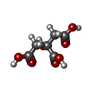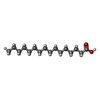[English] 日本語
 Yorodumi
Yorodumi- EMDB-63357: Cryo-EM structure of the G15C-R66C and T83C-T83C diabody complex ... -
+ Open data
Open data
- Basic information
Basic information
| Entry |  | ||||||||||||
|---|---|---|---|---|---|---|---|---|---|---|---|---|---|
| Title | Cryo-EM structure of the G15C-R66C and T83C-T83C diabody complex (CitS-diabody #7-TLR3) | ||||||||||||
 Map data Map data | |||||||||||||
 Sample Sample |
| ||||||||||||
 Keywords Keywords | Disulfide-bridged diabody / cryo-electron microscopy (cryo-EM) / small protein imaging / structural marker / antibody engineering / protein nanotechnology / STRUCTURAL PROTEIN / STRUCTURAL PROTEIN-IMMUNE SYSTEM complex | ||||||||||||
| Function / homology |  Function and homology information Function and homology informationTLR3 deficiency - HSE / response to dsRNA / UNC93B1 deficiency - HSE / type III interferon production / positive regulation of type III interferon production / TICAM1 deficiency - HSE / TRAF3 deficiency - HSE / regulation of dendritic cell cytokine production / Toll Like Receptor 3 (TLR3) Cascade / citrate metabolic process ...TLR3 deficiency - HSE / response to dsRNA / UNC93B1 deficiency - HSE / type III interferon production / positive regulation of type III interferon production / TICAM1 deficiency - HSE / TRAF3 deficiency - HSE / regulation of dendritic cell cytokine production / Toll Like Receptor 3 (TLR3) Cascade / citrate metabolic process / inflammatory response to wounding / TLR3-mediated TICAM1-dependent programmed cell death / activation of NF-kappaB-inducing kinase activity / toll-like receptor 3 signaling pathway / detection of virus / necroptotic signaling pathway / : / symporter activity / RIP-mediated NFkB activation via ZBP1 / endolysosome membrane / positive regulation of cytokine production involved in inflammatory response / Trafficking and processing of endosomal TLR / hyperosmotic response / positive regulation of macrophage cytokine production / toll-like receptor signaling pathway / sodium ion transport / pattern recognition receptor activity / cellular response to exogenous dsRNA / RSV-host interactions / response to exogenous dsRNA / negative regulation of osteoclast differentiation / ubiquitin-like protein ligase binding / positive regulation of interferon-alpha production / cellular response to interferon-beta / positive regulation of chemokine production / extrinsic apoptotic signaling pathway / JNK cascade / positive regulation of interleukin-12 production / Regulation of TBK1, IKKε-mediated activation of IRF3, IRF7 upon TLR3 ligation / extracellular matrix / TICAM1,TRAF6-dependent induction of TAK1 complex / TICAM1-dependent activation of IRF3/IRF7 / positive regulation of interferon-beta production / TICAM1, RIP1-mediated IKK complex recruitment / positive regulation of interleukin-8 production / positive regulation of JNK cascade / microglial cell activation / cellular response to mechanical stimulus / cellular response to virus / cellular response to type II interferon / positive regulation of interleukin-6 production / male gonad development / cellular response to xenobiotic stimulus / positive regulation of type II interferon production / positive regulation of angiogenesis / positive regulation of inflammatory response / positive regulation of tumor necrosis factor production / transmembrane signaling receptor activity / signaling receptor activity / double-stranded RNA binding / defense response to virus / early endosome / positive regulation of canonical NF-kappaB signal transduction / endosome membrane / defense response to bacterium / positive regulation of apoptotic process / Golgi membrane / lysosomal membrane / innate immune response / positive regulation of gene expression / endoplasmic reticulum membrane / signal transduction / positive regulation of transcription by RNA polymerase II / extracellular space / metal ion binding / identical protein binding / membrane / plasma membrane / cytoplasm Similarity search - Function | ||||||||||||
| Biological species |  Klebsiella pneumoniae (bacteria) / Klebsiella pneumoniae (bacteria) /  Homo sapiens (human) / synthetic construct (others) Homo sapiens (human) / synthetic construct (others) | ||||||||||||
| Method | single particle reconstruction / cryo EM / Resolution: 3.1 Å | ||||||||||||
 Authors Authors | Kim S / Kim JW / Park JG / Lee SS / Choi SH / Lee J-O / Jin MS | ||||||||||||
| Funding support |  Korea, Republic Of, 3 items Korea, Republic Of, 3 items
| ||||||||||||
 Citation Citation |  Journal: Structure / Year: 2025 Journal: Structure / Year: 2025Title: Disulfide-stabilized diabodies enable near-atomic cryo-EM imaging of small proteins: A case study of the bacterial Na/citrate symporter CitS. Authors: Subin Kim / Ji Won Kim / Jun Gyou Park / Sang Soo Lee / Seung Hun Choi / Jie-Oh Lee / Mi Sun Jin /  Abstract: Diabodies are engineered antibody fragments with two antigen-binding Fv domains. Previously, we demonstrated that they are often highly flexible but can be rigidified by introducing a disulfide bond ...Diabodies are engineered antibody fragments with two antigen-binding Fv domains. Previously, we demonstrated that they are often highly flexible but can be rigidified by introducing a disulfide bond at the Fv interface. In this study, we explored the potential of disulfide-bridged, bispecific diabodies for near-atomic cryoelectron microscopy (cryo-EM) imaging of small proteins because they can predictably link target proteins to "structural marker" proteins. As a case study, we used the bacterial citrate transporter CitS as the target protein, and the horseshoe-shaped ectodomain of human Toll-like receptor 3 (TLR3) as the marker. We show that diabodies containing one or two disulfide bonds enabled the 3D reconstruction of CitS at resolutions of 3.3 Å and 3.1 Å, respectively. This resolution surpassed previous crystallographic results and allowed us to visualize the high-resolution structural features of the transporter. Our work expands the application of diabodies in structural biology to address a key limitation in the field. | ||||||||||||
| History |
|
- Structure visualization
Structure visualization
| Supplemental images |
|---|
- Downloads & links
Downloads & links
-EMDB archive
| Map data |  emd_63357.map.gz emd_63357.map.gz | 42.3 MB |  EMDB map data format EMDB map data format | |
|---|---|---|---|---|
| Header (meta data) |  emd-63357-v30.xml emd-63357-v30.xml emd-63357.xml emd-63357.xml | 24.5 KB 24.5 KB | Display Display |  EMDB header EMDB header |
| Images |  emd_63357.png emd_63357.png | 111.6 KB | ||
| Filedesc metadata |  emd-63357.cif.gz emd-63357.cif.gz | 7.6 KB | ||
| Others |  emd_63357_half_map_1.map.gz emd_63357_half_map_1.map.gz emd_63357_half_map_2.map.gz emd_63357_half_map_2.map.gz | 77.6 MB 77.6 MB | ||
| Archive directory |  http://ftp.pdbj.org/pub/emdb/structures/EMD-63357 http://ftp.pdbj.org/pub/emdb/structures/EMD-63357 ftp://ftp.pdbj.org/pub/emdb/structures/EMD-63357 ftp://ftp.pdbj.org/pub/emdb/structures/EMD-63357 | HTTPS FTP |
-Validation report
| Summary document |  emd_63357_validation.pdf.gz emd_63357_validation.pdf.gz | 1002.1 KB | Display |  EMDB validaton report EMDB validaton report |
|---|---|---|---|---|
| Full document |  emd_63357_full_validation.pdf.gz emd_63357_full_validation.pdf.gz | 1001.6 KB | Display | |
| Data in XML |  emd_63357_validation.xml.gz emd_63357_validation.xml.gz | 12.9 KB | Display | |
| Data in CIF |  emd_63357_validation.cif.gz emd_63357_validation.cif.gz | 15.2 KB | Display | |
| Arichive directory |  https://ftp.pdbj.org/pub/emdb/validation_reports/EMD-63357 https://ftp.pdbj.org/pub/emdb/validation_reports/EMD-63357 ftp://ftp.pdbj.org/pub/emdb/validation_reports/EMD-63357 ftp://ftp.pdbj.org/pub/emdb/validation_reports/EMD-63357 | HTTPS FTP |
-Related structure data
| Related structure data |  9lsjMC  9lshC  9lsiC  9lskC M: atomic model generated by this map C: citing same article ( |
|---|---|
| Similar structure data | Similarity search - Function & homology  F&H Search F&H Search |
- Links
Links
| EMDB pages |  EMDB (EBI/PDBe) / EMDB (EBI/PDBe) /  EMDataResource EMDataResource |
|---|---|
| Related items in Molecule of the Month |
- Map
Map
| File |  Download / File: emd_63357.map.gz / Format: CCP4 / Size: 83.7 MB / Type: IMAGE STORED AS FLOATING POINT NUMBER (4 BYTES) Download / File: emd_63357.map.gz / Format: CCP4 / Size: 83.7 MB / Type: IMAGE STORED AS FLOATING POINT NUMBER (4 BYTES) | ||||||||||||||||||||||||||||||||||||
|---|---|---|---|---|---|---|---|---|---|---|---|---|---|---|---|---|---|---|---|---|---|---|---|---|---|---|---|---|---|---|---|---|---|---|---|---|---|
| Projections & slices | Image control
Images are generated by Spider. | ||||||||||||||||||||||||||||||||||||
| Voxel size | X=Y=Z: 1.05 Å | ||||||||||||||||||||||||||||||||||||
| Density |
| ||||||||||||||||||||||||||||||||||||
| Symmetry | Space group: 1 | ||||||||||||||||||||||||||||||||||||
| Details | EMDB XML:
|
-Supplemental data
-Half map: #2
| File | emd_63357_half_map_1.map | ||||||||||||
|---|---|---|---|---|---|---|---|---|---|---|---|---|---|
| Projections & Slices |
| ||||||||||||
| Density Histograms |
-Half map: #1
| File | emd_63357_half_map_2.map | ||||||||||||
|---|---|---|---|---|---|---|---|---|---|---|---|---|---|
| Projections & Slices |
| ||||||||||||
| Density Histograms |
- Sample components
Sample components
+Entire : CitS-diabody #1-TLR3 complex
+Supramolecule #1: CitS-diabody #1-TLR3 complex
+Supramolecule #2: CitS
+Supramolecule #3: TLR3
+Supramolecule #4: Diabody
+Macromolecule #1: Citrate/sodium symporter
+Macromolecule #2: Toll-like receptor 3
+Macromolecule #3: Diabody (CitS VH-TLR3 VL)
+Macromolecule #4: Diabody (TLR3 VH-CitS VL)
+Macromolecule #7: CITRIC ACID
+Macromolecule #8: PALMITIC ACID
+Macromolecule #9: 2-acetamido-2-deoxy-beta-D-glucopyranose
-Experimental details
-Structure determination
| Method | cryo EM |
|---|---|
 Processing Processing | single particle reconstruction |
| Aggregation state | particle |
- Sample preparation
Sample preparation
| Buffer | pH: 7.5 |
|---|---|
| Vitrification | Cryogen name: ETHANE |
- Electron microscopy
Electron microscopy
| Microscope | TFS KRIOS |
|---|---|
| Image recording | Film or detector model: GATAN K3 BIOQUANTUM (6k x 4k) / Average electron dose: 60.0 e/Å2 |
| Electron beam | Acceleration voltage: 300 kV / Electron source:  FIELD EMISSION GUN FIELD EMISSION GUN |
| Electron optics | Illumination mode: FLOOD BEAM / Imaging mode: BRIGHT FIELD / Nominal defocus max: 2.0 µm / Nominal defocus min: 0.8 µm |
| Experimental equipment |  Model: Titan Krios / Image courtesy: FEI Company |
 Movie
Movie Controller
Controller















 Z (Sec.)
Z (Sec.) Y (Row.)
Y (Row.) X (Col.)
X (Col.)




































 Trichoplusia ni (cabbage looper)
Trichoplusia ni (cabbage looper)


